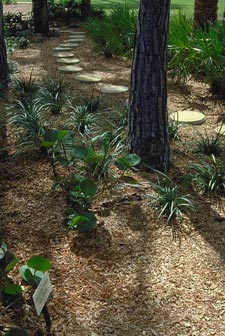Landscaping for Energy Efficiency
Landscaping is a good way to keep energy costs down. Landscapes that keep the sun away from the east and west walls reduces the amount of heat flow into a house. When heat is transferred into the home, your A/C has to operate longer and harder, thus using more energy. Plants and trees that cast shadows over the east and west walls can reduce indoor temperatures by as much as 20°F in the summer.
-
Starting the Planning Process
A good way to start the landscape planning process is to make a bird's eye drawing of your home. Mark east and west directions on your plan and include all and any existing trees and/or shrubs. This will help you decide where to plant the appropriate vegetation.

-
Planning Tips
Here are a few tips to keep in mind during the planning process:
- Plant trees and shrubs so they can direct breezes. Remove low branches to allow for maximum air movement. Plants and trees release large amounts of water from the pores in their leaves, and this evaporative cooling process can create a zone around the plant as much as 9°F cooler than the surrounding air temperature.
- Plant shade-casting plants around the air conditioning compressor so it doesn't have to work so hard. Be sure that leaves and branches do not block the airflow and periodically check for fallen leaves.
- Set trellises away from the house to allow air to circulate and keep vines from possibly damaging the exterior surfaces.
- Consider using bark or woodchips for walkways. This helps to keep the yard cooler and provides drainage for water.
- Plant natives. Use native plant species that are adapted to the soils and local environment.
Additional Resources
- EnergyStar
- Florida Energy Extension Service
- Florida House Learning Center
- Florida Solar Energy Center
- Office of Energy Efficiency and Renewable Energy | U.S. Department of Energy



